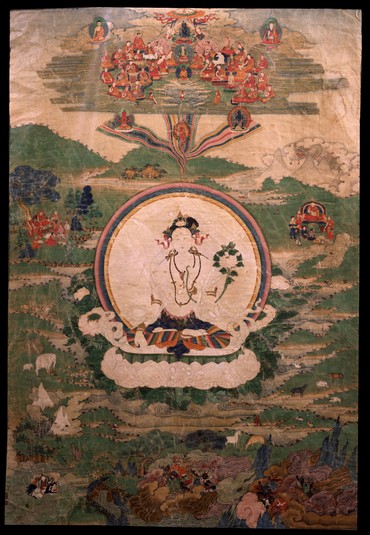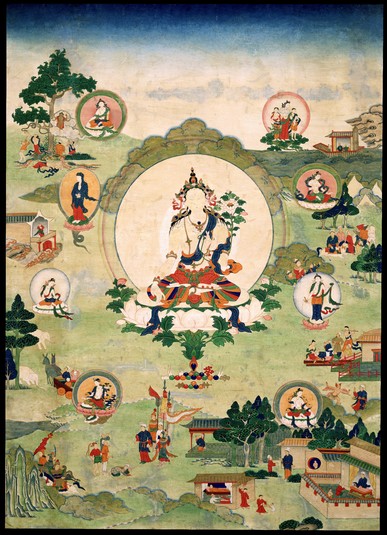
(18th Century Karma Kagyu thangka, with 13th Karmapa depicted in it).
Today for Tārā day, I offer the first translation and publication of a very concise White Tārā daily practice composed by the 13th Karmapa, Dudul Dorje (dDud-‘dul rDo-rje, 1733-1797). The text (compiled in English, Tibetan and phonetics) can be downloaded freely here .
This post also pulls together some of the interesting aspects about the 13th Karmapa’s life and miracles, and provides details on the sources of his composition on White Tārā.
13th Karmapa – birth and recognition

Karmapa Dudul Dorje was born at Chawa Drongsar, south Tibet. He was recognized at the age of four and enthroned by 7th Goshir Gyaltsab Rinpoche and Nyingma master, Kathog Rigdzin Tsewang Norbu. The then ruler of Tibet, the seventh Dalai Lama, Kalzang Gyatso, with his prime minister, Sonam Topgyal, instituted a rule that all government officials must be Gelugpa. As a consequence of this, the Dalai Lama’s approval of the new Karmapa incarnation was required. At the age of eight, he met his main guru, the great Eight Situpa, Chökyi Jungne, whose long life had spanned all of the 12th Karmapa’s and was to span most of the 13th. Dudul Dorje received the Kagyu transmissions from him and also studied the Nyingma teachings very extensively. He appears to have been like a spiritual Dr. Doolittle, who was very fond of animals and famous for communicating with them[i], more on that in another post!
Jokhang Temple, Letter to the King of the Nagas and Jowo Statue’s Moving Arms
The story about the 13th Karmapa’s miracles at the Jokhang Temple, Tibet can be found in various biographical sources (see Bibliography). At one point the famous Jokhang temple, home of the Jowo image, was threatened by rising flood waters. A prophecy from Guru Rinpoche, in a Nyingma terma (sPyi lung ‘od kyi lta ba) had foreseen this and predicted that only the Karmapa could do something to stop it, as it was caused by a powerful serpentine spirit (naga). The Lhasa authorities requested him to come. Being unable to leave immediately, he dealt with the problem by writing a special letter to the naga and invoking the compassion of Avalokiteshvara. When the letter was placed on the statue the water is said to have stopped. Then, when the 13th Karmapa later visited the statue, the arms moved into a different position to receive the white katag scarf he offered to it. The 8th Dalai Lama, Jampel Gyatso received him and thanked him for his actions.
Restoration of the Swayambu Stupa, Nepal in 1750

Swayambhu, now a UNESCO World Heritage Site, goes back to ancient times. The earliest written record of the Great Stupa of Swayambhu (see image above) is a 5th century stone inscription. Honoured by kings, monks, and pilgrims alike, the stupa has been restored and repaired on numerous occasions. Around 1750, the 13th Karmapa also made a pilgrimage to Nepal and visited the Nepali King, Jaya Prakasamalla, there and arranged for restoration to be undertaken on it. This reparation is engraved in stone there and a copy of it is said to be in the Cambridge University library (although I was unable to find this online). Keith Dowman explains that:
“The 6th Zhamarpa had the four gilt shrines placed at the cardinal directions in 1614. Rang-rig-ras-pa had a new pinnacle (ganjira) erected during the reign of Parthivendra Malla, the consecration taking place in 1694. The next major restoration was consecrated in 1750, probably in the wake of an earthquake, as the extensive restoration included the environs of the Stupa. Ka-thog Rig-‘dzin-chen-po, the 13th Karmapa and Situ Pan-chen were the patrons of this restoration. The Tibetan inscription on the pillar on the S.E. side of the Stupa commemorates this event. “
The Text – Daily Practice of ‘Actually Realising’ White Tārā
The 13th Karmapa’s Collected Works are contained in two volumes, an English translation of the outline of the works can be seen here. It is certainly a treasury of interesting texts, advice and songs, (including those of humming bees!). I plan to do more translations of these works in the near future. The text itself, Actually Realising White Tārā Daily Practice can be found in his Collected Works but also in Collection of Works by the Karmapas[ii] published in Lhasa, Tibet in 2013.
The title uses the Tibetan term mngon rtogs, which can mean ‘practice’ or ‘visualisation’ in terms of a sadhana, but its literal meaning is the ‘actual realization’ of that visualization, not just the act of visualizing. Thus, I have translated it with that meaning in mind. The colophon states that, it was ‘Written by the 13th Karmapa as desired by Mipham Sherab.’[iii] The 13th Karmapa also wrote a Supplication to Noble Tārā [iv] (which is also White Tārā), which is found in the same collection. I will translate this in the near future.

The cover image used for the new translation is an image of White Tārā in the Karma Kagyu tradition. The information for it states that: “At the middle right, is the 13th Karmapa surrounded by attendants and students. At the middle left sits a red hat lama (likely to be Situ Panchen Chokyi Jungne) surrounded by attendants and students. Above the central figure standing on ribbons of rainbow light are Vajravarahi surrounded by flames, to the left Jinasagara Avalokiteshvara, red, with four hands and on the right side a solitary Chakrasamvara, dark blue in colour. At the top centre, is the primordial Buddha Vajradhara with Vajrasattva below and the Buddha Amitabha below that. Surrounding those are the lineage teachers of the Karma Kagyu tradition; Tilopa, Naropa, Marpa, Milarepa, Gampopa, Karmapa Dusum Khyenpa and the like, continuing down to the 12th Karmapa. At the top left is the Buddha Shakyamuni and at the right is Guru Rinpoche Padmasambhava.” More details about the image can be seen here: https://www.himalayanart.org/items/90401

Here is a video of HH 17th Karmapa reciting the White Tara mantra:
May this new translation of this White Tārā text be of benefit in preserving the Tārā practice and texts and promoting the activities of the Karmapas, the Dharma and bringing all beings to the state of Noble Tārā !
Adele Tomlin, 23rd November 2020.
ENDNOTES
[i] During the time of the 13th Karmapa, the 8th Shamarpa only lived for eight years, precipitating another controversy. Subsequently, Karmapa Dudul Dorje and Situ Chokyi Jungnay, once again helped by Katog Rigdzin Tsewang Norbu, recognised Shamarpa’s reincarnation as a younger brother of the fourth Panchen Lama, Palden Yeshe. The seventh Gyaltsab Rinpoche (1699-1765), however, had already installed a son of the wealthy Ger Namsayling family as the reincarnation, with the approval of Shamarpa’s monks at Yangpachen monastery, his principal seat in Tibet. The dispute eventually reached the courts, where it was decided that the Karmapa had indeed located the true incarnation, Shamarpa Mipam Chodrub Gyamtso, who became the principal disciple of both Karmapa Dudul Dorje and Situ Chokyi Jungnay, and the next lineage holder.
[ii] “sgrol dkar mngon rtogs rgyun khyer/.” In karma pa sku phreng rim byon gyi gsung ‘bum phyogs bsgrigs/. TBRC W3PD1288. 92: 145 – 147. lha sa/: dpal brtsegs bod yig dpe rnying zhib ‘jug khang /, 2013?.
[iii] It is not known who Mipham Sherab is here.
[iv] rje btsun ‘phags ma sgrol ma’i gsol ‘debs/ karma pa sku phreng rim byon gyi gsung ‘bum phyogs bsgrigs/. In karma pa sku phreng rim byon gyi gsung ‘bum phyogs bsgrigs/. TBRC W3PD1288.Volume 92 Pages 147 – 149.
Further Reading/Biography
- Douglas, Nik and White, Meryl (1976) Karmapa the Black Hat Lama of Tibet, (Luzac & Company Ltd).
- Ken Holmes, (1995) Karmapa, Altea Publishing, Author’s website.
- Dowman, Keith A Buddhist Guide to the Power Places of the Kathmandu Valley. http://keithdowman.net/essays/guide-to-kathmandu-valley.html
- Holmes, Ken (1995), Karmapa.

Where is it??
Sent from Mail for Windows 10
You have to request it in an email. Please use the contact form. Thanks!
H.E Garchen Rinpoche life was saved 8 times by White Tara. On internet there is story about it in Rinpoche own words. Swayambu Stupa was visited by Marpa on his way to India.
Yes, I am a big admirer of Garchen Rinpoche and have met him personally and taken empowerments from him. I am also good friends with his amazing translator, Ina Bieler. Do tell more about Marpa’s visit to Swayambu, sounds interesting!
Relying on memory, in Trungpa Rinpoche edition of Marpa biography there is short notice that on his way to India, Marpa spent some time ( months? years?) in Nepal to learn Indian language ( Sanskrit?) and get his lungs used to India climate.
And during that period Marpa visited Swayambu Stupa. No any special events or miracles during visiting Swayambu.
Interesting, in Marpa biography ( Trungpa Rinpoche edition ) there is Marpa farewell song which he sang at occasion of ending his study and practice in India and in this song Marpa mentioned his Indian consort, daughter of restaurant owner. Everybody knows that Marpa met great gurus in India but not many knows that Marpa practiced with Indian consort. In Tranghu
Rinpoche edition of Marpa biography there is rare jewel it mean twelve instructions which Maitripa sang to Marpa.
Yes Adele , would very much appreciate a copy of your translation of the Tara sadhana by the 13th Karmapa. Have been blessed to receive multiple White Tara empowerments and done several closed group and solitary White Tara retreats over the years.
Tara study and practice is truly an inexhaustible treasury of spiritual insight and realisation. Thank you for your wonderful efforts and passion in bringing Dharma to life through your heartfelt translations . . .
Hello Paul thanks for your interest and kind comments. Of course I can send you the text via email. It is also now available to download in the post itself. Great to hear you are so close to White Tara. She is a life saver for sure! 😁👸